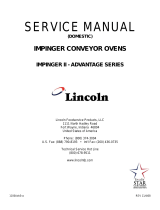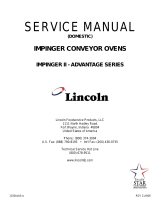
Impinger II –1100 Series Service Manual - Domestic
2
TABLE OF CONTENTS
SEQUENCE OF OPERATIONS 1100 thru 1103 .....................................................................................................3
SEQUENCE OF OPERATIONS 1116 - 1117 ..........................................................................................................4
SEQUENCE OF OPERATIONS 1130 - 1133 & 1160 - 1163...................................................................................6
SCHEMATIC 1100 – 1101 .......................................................................................................................................8
SCHEMATIC 1102-1103..........................................................................................................................................9
SCHEMATIC 1116 – 1117 S/N 2011383 & BELOW..............................................................................................10
SCHEMATIC 1116 – 1117 S/N 2011384 & ABOVE ..............................................................................................11
SCHEMATIC 1130 – 1131 S/N 2011383 & BELOW & 1160 – 1161 S/N 2011978 & BELOW..............................12
SCHEMATIC 1130 – 1131 S/N 2011384 & ABOVE ..............................................................................................13
SCHEMATIC 1160 – 1161 S/N 2011978 & ABOVE ..............................................................................................14
SCHEMATIC 1132 – 1133 S/N 2011383 & BELOW & 1162 – 1163 S/N 2011979 & BELOW..............................15
SCHEMATIC 1132 – 1133 S/N 2011384 & ABOVE ..............................................................................................16
SCHEMATIC 1162 – 1163 S/N 2011978 & ABOVE ..............................................................................................17
TROUBLESHOOTING GUIDE 1116 - 1117...........................................................................................................18
TROUBLESHOOTING GUIDE 1100 THRU 1103..................................................................................................22
TROUBLESHOOTING GUIDE 1130 THRU 1133 / 1160 THRU 1163...................................................................24
REMOVAL, INSTALLATION, AND ADJUSTMENT ...............................................................................................31
PARTS / GENERAL –1100 SERIES......................................................................................................................50
BLOW UP / GENERAL – 1100 SERIES.................................................................................................................51
PARTS / CONTROL COMPARTMENT FRONT 1100 - 1106, 1130 - 1136, 1150,1151,1160 – 1163..................52
BLOW UP / CONTROL COMPARTMENT FRONT 1100 – 1106,1130 – 1136, 1150,1151,1160 – 1163.............53
PARTS / CONTROL. COMPARTMENT FRONT 1116,1117.................................................................................54
BLOW UP / CONTROL COMPARTMENT FRONT 1116, 1117.............................................................................55
PARTS / CONTROL COMPARTMENT REAR 1100 – 1106, 1130 – 1136, 1150,1151, S/N 2011373 & BELOW, 1160
– 1163 S/N 2011978 & BELOW.............................................................................................................................56
BLOW UP / CONTROL COMPARTMENT REAR 1100 – 1106, 1130 – 1136, 1150,1151, S/N 2011373 & BELOW,
1160 – 1163 S/N 2011978 & BELOW....................................................................................................................57
PARTS / CONTROL COMPARTMENT REAR 1130 - 1136, 1150, 1151, S/N2011383 AND ABOVE, 1160 – 1163 S/N
3011978 AND ABOVE............................................................................................................................................58
BLOW UP / CONTROL COMPARTMENT REAR 1130 - 1136, 1150, 1151, S/N2011383 AND ABOVE, 1160 – 1163
S/N 3011978 AND ABOVE.....................................................................................................................................59
PARTS / CONTROL COMPARTMENT REAR 1116, 1117, S/N 2000200 TO 2011383.......................................60
BLOW UP / CONTROL COMPARTMENT REAR 1116, 1117, S/N 2000200 TO 2011383...................................61
PARTS / CONTROL COMPARTMENT REAR 1116, 1117 S/N 2011383 & ABOVE ............................................62
BLOW UP / CONTROL COMPARTMENT REAR 1116, 1117 S/N 2011383 & ABOVE........................................63
PARTS / OVEN BACK ASSEMBLY 1100 SERIES................................................................................................64
BLOW UP / OVEN BACK ASSEMBLY 1100 SERIES...........................................................................................65
PARTS / GEARMOTOR ASSEMBLY 1100 SERIES.............................................................................................66
BLOW UP / GEARMOTOR ASSEMBLY 1100 SERIES.........................................................................................67
PARTS / CONVEYOR & DOOR 1100 SERIES .....................................................................................................68
BLOW UP / CONVEYOR & DOOR 1100 SERIES.................................................................................................69




























